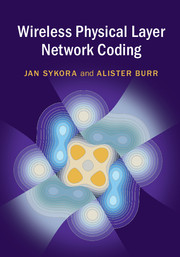Book contents
- Frontmatter
- Contents
- Preface
- Mathematical Symbols
- Abbreviations
- Part I Motivation and Gentle Introduction
- Part II Fundamental Principles of WPNC
- Part III Design of Source, Relay, and Destination Strategies
- 6 NCM and Hierarchical Decoding Design for H-MAC
- 7 NCM Design and Processing for Parametric Channels
- 8 NCM Design for Partial HSI and Asymmetric H-MAC
- 9 Joint Hierarchical Interference Processing
- 10 WPNC in Complex Stochastic Networks
- Appendix A Background Theory and Selected Fundamentals
- References
- Index
10 - WPNC in Complex Stochastic Networks
from Part III - Design of Source, Relay, and Destination Strategies
Published online by Cambridge University Press: 01 February 2018
- Frontmatter
- Contents
- Preface
- Mathematical Symbols
- Abbreviations
- Part I Motivation and Gentle Introduction
- Part II Fundamental Principles of WPNC
- Part III Design of Source, Relay, and Destination Strategies
- 6 NCM and Hierarchical Decoding Design for H-MAC
- 7 NCM Design and Processing for Parametric Channels
- 8 NCM Design for Partial HSI and Asymmetric H-MAC
- 9 Joint Hierarchical Interference Processing
- 10 WPNC in Complex Stochastic Networks
- Appendix A Background Theory and Selected Fundamentals
- References
- Index
Summary
Principles of Wireless Cloud Coding
The termWireless Cloud Coding (WCC) will denote the coding concept suited for large and complex networks with a stochastic structure and connectivity. A simple low-scale WPNC network with a known deterministic structure can be designed in a “handcrafted” style.We usually also easily identify the critical points of performance or design aspects that need to be optimized. On the other hand, a complex large stochastic network adds some specific problems.
Stochastic Network Structure
The network structure and connectivity may be stochastic and unknown. A standard NCM design needs to know the participating signals forming the H-constellation in the H-MAC stage, and also the full end-to-end hierarchical encapsulation of all involved HNC maps to guarantee the end-to-end solvability. In a large randomly changing network, this creates a significant problem for (a) identifying and estimating the system/ channel state, (b) making a decision on the processing form, and (c) signaling this decision to all involved nodes. Instead of using this traditional solution, we can try to devise the NCM that is blind to the network structure that will not require a separate NCM/WPNC control protocol but will treat the unknown network structure as an additional degree of freedom fully integrated with the actual payload data (see Section 10.2).
Clustered, Nested, and Modular Cloud Framework
The number of the design degrees of freedom may be prohibiting in a large network. A nested modular encapsulation of some of its fragments/clusters can help. This has two aspects. (a) It simplifies the overall design by clustering the nodes and nesting the clusters. (b) Each cluster performs some processing as a “black-box” self-contained virtual super-node. It does not reveal its internal structure to the outside world and simply provides some functionality as a super-node. Its global level of clustering can even comprise the whole cloud. It can serve its outside terminals as if it was some super-relay performing some complex internal hidden processing (see Section 10.3).
Wireless Cloud-Coding-Based Design of NCM
Random Channel Class H-MAC and Joint HNC Map
Joint HNC map vs. Classical Signaling
A classical signaling solution (Figure 10.1a) is based on the channel sensing and then switching the NCM map at the node depending on the channel class (connection/ disconnection).
- Type
- Chapter
- Information
- Wireless Physical Layer Network Coding , pp. 270 - 283Publisher: Cambridge University PressPrint publication year: 2018



